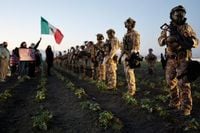On a warm September evening in Santa Ana, California, the intersection of Bristol and 1st Street became the stage for a protest that reverberated far beyond the city’s borders. About 30 community members gathered on September 19, 2025, to voice outrage at a Supreme Court ruling handed down just days earlier—one that, in their eyes, sanctioned racial profiling by federal immigration agents and set a dangerous precedent for the nation.
The demonstration, organized as a response to a call to action from the Legalization for All Network and supported by Community Service Orange County (CSO OC) as well as Lucha Santa Ana activists, was both a rally and a memorial. Protesters held aloft signs reading “No racist racial profiling!” and “No more deaths at the hands of ICE!” as passing cars honked in support. The crowd chanted, “No more profiling! No more deportations!” and “ICE out of OC!”—a refrain echoing the anxiety gripping immigrant communities across Southern California.
At the heart of the protest was a solemn remembrance for three men whose lives, activists say, were cut short directly or indirectly by Immigration and Customs Enforcement (ICE) actions: Jaime Alanis Garcia, Roberto Carlos Montoya Valdez, and Silverio Villegas-Gonzalez. Their names were spoken aloud, candles were lit, and families’ words were displayed alongside photographs and bouquets, transforming a busy corner into a space of collective mourning and resistance.
Kevin Trujillo of CSO OC opened the gathering with a blunt assessment: “All this racial profiling is gonna do is lead to more brown people getting killed and injured. That's why we as a community are letting people know that we won't stand for this.” According to Fight Back! News, Trujillo’s words set the tone for a protest that was as much about demanding justice for the dead as it was about fighting for the living.
Rain Mendoza, also with CSO OC, spoke to the crowd about the broader implications of the Supreme Court’s September 8 ruling. “This is the continuation of the ramped up racist oppression Chicanos, Latinos and immigrant communities have been facing since Trump took office,” Mendoza said, underscoring fears that the decision would disproportionately target those who speak Spanish, have accents, or work in blue-collar jobs.
The stories of the three men memorialized that night painted a stark picture of the ruling’s human cost. Jaime Alanis Garcia lost his life after falling 30 feet from a building while fleeing an ICE raid at Glass House Farms in Camarillo on July 10. Roberto Carlos Montoya Valdez was fatally struck on the 210 Freeway on August 14 after escaping an ICE operation at a Home Depot in Monrovia. Silverio Villegas-Gonzalez was shot and killed on September 12 after ICE agents attempted to detain him during his morning commute, just after he had dropped his children at daycare. All three, Mendoza emphasized, were simply working to provide for their families when tragedy struck.
Beyond Santa Ana, the reverberations of the Supreme Court’s decision were being felt and debated nationwide. On September 15, 2025, the Court, in a 6-3 ruling delivered via its shadow docket, lifted an injunction that had previously prevented federal immigration officials in Southern California from considering race, language, location, and job type when making detentive stops. Justice Brett Kavanaugh, in a concurring opinion, cited the 1975 precedent United States v. Brignoni-Ponce, which controversially allowed “Mexican appearance” to be a factor in forming reasonable suspicion for immigration stops.
Critics, including law professors and former immigration judges quoted by Slate, argue that this logic flies in the face of the Court’s recent pronouncements on constitutional colorblindness. Just two years ago, the same conservative majority ended affirmative action in higher education with Students for Fair Admissions v. Harvard, insisting that the government must not make distinctions based on race under the 14th Amendment’s equal protection clause. Justice Clarence Thomas once wrote, “The government may not make distinctions on the basis of race.” Yet, as Slate notes, the new ruling effectively permits such distinctions in immigration enforcement, leaving many to question the consistency of the Court’s approach.
Justice Sonia Sotomayor, in her dissent, warned against the use of racial appearance as a law enforcement tool, highlighting the inherent dangers of allowing immutable traits to serve as proxies for suspicion. The decision, she argued, undermines the very bedrock rights that are supposed to protect individuals from government overreach and discrimination.
Ronald Brownstein, writing for Tribune News Service, described the ruling as emblematic of a “split-level legal paradigm.” While the Trump administration and the Court’s Republican-appointed majority have moved to eliminate the use of race in government decision-making—banning it in college admissions, public sector employment, and government contracting—they have simultaneously endorsed its use in immigration enforcement. Brownstein quoted Aderson Francois, a Georgetown Law School professor specializing in civil rights, who observed, “It seems clear that this (John) Roberts Court’s belief is that ... race is a sword that can be used against racial minorities, but it can never be a shield to protect them.”
This duality is not lost on lawmakers, either. During Justice Kavanaugh’s 2018 confirmation hearings, Senator Cory Booker predicted that Kavanaugh would support racial profiling in law enforcement while opposing race-conscious remedies for discrimination. Booker’s forecast, it appears, was prescient—Kavanaugh’s concurrence in the recent ICE ruling argued that factors such as ethnicity, English proficiency, and employment type could all be considered in immigration stops.
Civil rights advocates worry that the ruling’s logic could extend beyond immigration, potentially opening the door to broader racial profiling in criminal law enforcement. Jin Hee Lee, director of strategic initiatives at the Legal Defense Fund, told Tribune News Service that the decision is difficult to reconcile with “clear Supreme Court precedent” barring the use of racial stereotypes in the criminal legal system.
Meanwhile, on the ground in Los Angeles—the epicenter of these enforcement operations—the consequences are immediate and personal. As Slate reported, Angelenos have been stopped on their way to work, church, or school based on perceived ancestry, and families with mixed immigration status live in fear that loved ones might not return home. Organizations like the Acacia Center for Justice are working to educate communities and prepare legal defenses for those now at greater risk of detention. Yet, as legal experts point out, no amount of training can justify what they see as the abandonment of basic constitutional protections.
Back in Santa Ana, Izzy Mirez, a local activist, captured the urgency of the moment: “We're not just here to talk about stuff. We have to be moved to action. We have to move to break what is truly wrong with the machine.” As the protest concluded, Trujillo urged those present to join CSO OC’s campaign to halt ICE arrests at the Santa Ana immigration court, vowing that their fight would continue.
The Supreme Court’s ruling, and the passionate response it has provoked, have laid bare the fault lines in America’s ongoing struggle with race, justice, and the meaning of equal protection under the law. For those on the streets of Santa Ana and in communities across the country, the debate is no longer theoretical—it’s a matter of life, death, and the future of civil rights in the United States.


